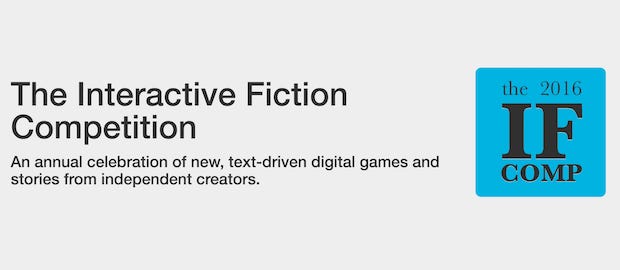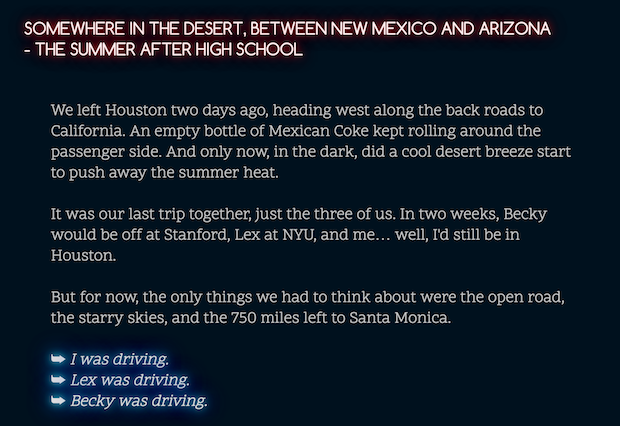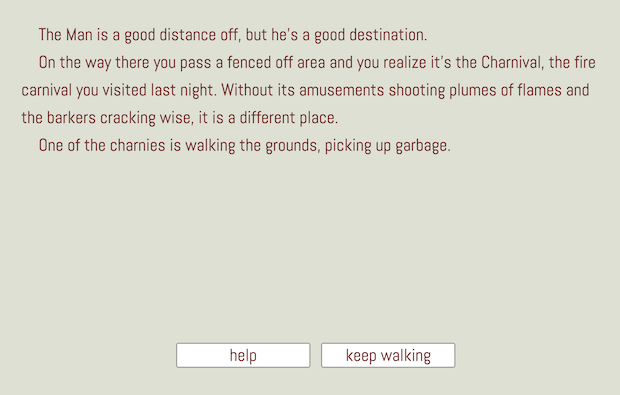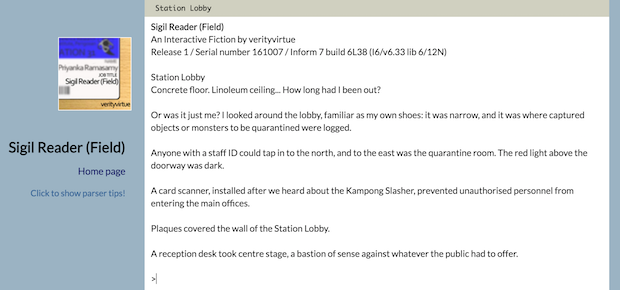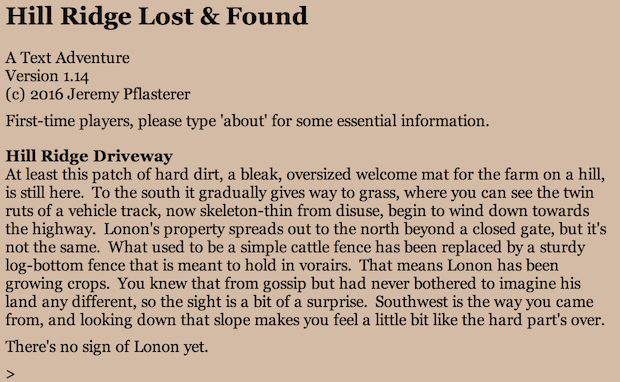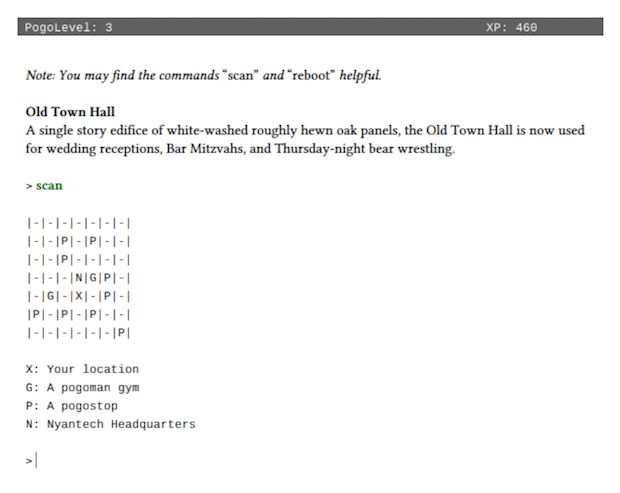IF Only: All About The Setting
Four new pieces of IF to recommend
IF Comp 2016 continues to run, with a diverse range of fascinating games. And there's still time for you to play and judge five of them if you wish!
This week, I'm taking a look at some Comp pieces that are particularly rich in setting. Letting the player explore a place deeply and really get to know it has always been one of the strengths of interactive fiction, and the XYZZY Award for Best Setting is hotly contested most years.
Cactus Blue Motel (Astrid Dalmady, choice-based, Twine) tells of a stop on a road trip through the American Southwest. After an evening of driving and low-key disagreement about the music, you and your friends wind up someplace not far off the Hotel California: run-down, kitschy, apparently empty, but actually holding on to the spirits of passers-by who needed a break from their regular lives over the course of many years. The descriptions beautifully capture the desert, the neon, the leftover decor from the 50s, 60s, and 70s. Trying to figure out what is going on at the hotel means you have to confront what's going on in your own life as well.
Dalmady's written several well-received Twine works before. Last year's Arcane Intern (Unpaid) got a nomination for Best Story at the XYZZY Awards. Her deep-sea exploration game Tangaroa Deep tied for first place in a competition earlier this year. Both combine a lot of real world observation with elements of the magical and mysterious.
Cactus Blue Motel is my favorite of her work so far. In common with several of her previous pieces, it's playing with the awe-inspiring and the mystical that underlies reality. But the dialogue goes deeper, the characters are more developed, the pacing more confident. From the way the choices played out and the way the endgame was worded, I have the strong impression there were multiple other endings I could have reached, but I was satisfied with the ending that I found on my playthrough. It felt right to me.
Black Rock City (Jim Munroe, Texture) is set in the desert as well: the playa of Burning Man. It's a story about exploring that environment — its surreal artworks, its unusual social norms, its sudden dust storms — with no particular goal or expected outcome.
The narrative structure here is what IF community theorists like Sam Ashwell would call a Time Cave, after the very earliest Choose Your Own Adventure book: pretty much every choice you make leads you to a fresh, unique situation, with the narrative branching widely. Play again and you'll wind up somewhere completely different. Time caves tend to be unpredictable for the player: you can't really make a plan and execute it, and instead you're just exploring and seeing where you wind up. But for this particular subject matter, all about surprise and serendipity and being outside typical expectations, it works well.
Sigil Reader (Field) (verityvirtue, parser, Inform) takes place among the monster-hunters of Perigosan — an alternate-world version of the author's native Singapore that appeared in her previous piece Walker's Rift. The setting combines fantasy and horror elements, such as the mind-and-behavior-warping sigils, with a bit of bureaucratic satire.
As the name Sigil Reader (Field) suggests, the protagonist's main ability lies in being able to see arcane evidence and figure out its meaning. And this is very much a piece about exploring what happened in its space in the past, not changing what is going on in the present. Even so, it's still possible to reach several different endings, depending on how the protagonist chooses to remember the past and what she thinks about her own role in the unfolding events.
Meanwhile, the southeast Asian context comes through in everything from character names to food descriptions to subtler aspects about the organization of the bureaucracy. This is especially welcome considering how comparatively little interactive fiction is set in this region. (Though see also The Empire's Edge by Chan Sing Goh, a PDF gamebook set in 1811 Penang, which includes mechanical features to represent the diversity of languages and cultures on the island at the time.)
Hill Ridge Lost and Found (Jeremy Pflasterer, parser, TADS 3) is a puzzle game set in a place that feels like it's meant to be rural America, just a bit displaced from our own universe. The flora and fauna aren't what you might be used to. Hill Ridge farm relies on a working animal called a vorair that combines qualities of a bull, an armadillo, and a cat. There are several plants that do not behave like the plants you might be accustomed to. When you're not discovering and manipulating these elements, you're interacting with the farm's elderly, cranky machinery, amending the places where it's rusted or lost bits: a world that may be unfamiliar more through age and technological change than because of any difference between our universe and its.
These interactions flesh out the character of the farm's owner, the missing Lonon. Hill Ridge is not an easy place. Crops grow only with a lot of effort, and not necessarily in a satisfying quantity. Food is hard to cook. Water is hard to extract from the ground.
As a piece of design, Hill Ridge is aimed squarely at veteran players of parser IF. It even says so in the ABOUT file, but there are plenty of other pieces of evidence. Puzzles rely on some syntax that most experienced parser players will know about, but that might be obscure to new players (in particular, PUSH OBJECT WEST to move bulky items from one room to another). There are points where it's possible to destroy vital items. The game assumes that you're being diligent about keeping saves. There were also points where I wasn't sure what the protagonist was supposed to be working on next. It wasn't until I went to the walkthrough that I discovered TALK TO SELF as a (setting-appropriate) way of eliciting information about my current goals and intentions. Still, by and large, I found the puzzles fair and enjoyable, and the implementation solid.
This Comp contains a number of inventive and novel IF pieces of all kinds — including different choice and UI models, and some experimental parser pieces like Take and Mirror and Queen that do unconventional things with the player's typed input — but it's nice also to see some traditional-styled parser game play also well-represented in the group. This is such a piece.
Pogomon GO! (Jack Welch and Ben Collins-Sussman, parser, Inform) is, obviously, a Pokémon Go! parody.
I was, I confess, fairly skeptical about this premise going in. I've played enough text-based demakes of well-known games that that idea doesn't necessarily excite me by itself. (If you're curious, IF Arcade is a collection of classic arcade games reimagined in text; then there's IF Quake, and Dirk, which is a de-make of Dragon's Lair, and there are loads of others, at various degrees of seriousness, sophistication, and departure-from-the-concept-of-the-original.)
For the first few minutes of play, I thought possibly Pogomon Go! was just demonstrating how graphical game mechanics would become ridiculous if rendered in text — not to mention how goofy it is to recreate a game about getting up and moving around in such a way that you can collect all the monsters you want without moving off your sofa.
That said, I was inclined to extend some benefit of the doubt. The authors are known — in fact, they won the Comp in 2009 with Rover's Day Out, a game simultaneously about dogs and spacecraft. Their western-themed escape game Hoosegow got a pretty good reception too. And I found that they haven't lost their touch. Once I got past initial doubts about the theme, I enjoyed Pogomon GO! quite a bit — even getting caught up in the need to Collect Them All, at least for a while.
There's also more to the game than just the poke-cloning. Your longer-term goal is to prove yourself as a loyal gamer and potential beta-tester of the game. When that goal comes into play, Pogomon GO! becomes a bit more like a traditional text adventure, with somewhat more traditional puzzles. At the same time, it extends its joky riffing to parody tech company culture, with the in-building cafeterias and playgrounds-for-adults. The story never ceases to be silly, but the designers do have a good sense for when a particular mechanic has gone on long enough.
There are built-in hints, which came in handy once or twice when I got lost in the midgame, but I didn't rely on them for most of the interactions. My playthrough took me a little less than two hours, though there were a number of additional things I could in theory have replayed to achieve.
[Disclosures: Emily has met the authors of Cactus Blue Motel, Black Rock City, Sigil Reader (Field), and Pogomon GO!. More generally, Emily is not a journalist by trade and works professionally with various interactive fiction publishers. You can find out more about her commercial affiliations at her website.]
